59 Search Results for aac and aphasia
June 30, 2019
by Carole Zangari -
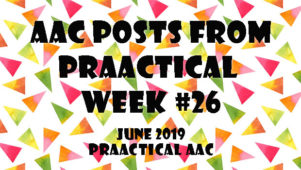
Happy Sunday, AAC friends! We’ve got a few posts for you to browse through from our prAACtical week. Monday – How I Do It: Pocket Flipbooks for Teens Tuesday – AAC Link Up Wednesday – Video of the Week: Activities to Use in AAC Training Thursday – PrAACtically July: AAC Resources for A Year of Core Vocabulary :::::::::::::::::::::::::::::::::::::::::::::::::::::::::::::::::::::::::::::::::::::::::::::::::::::::::::::::::::::::::::: Before you go, take a look and see if any of these are of interest. AAC Assessment Forms AAC Printables & Downloads AAC Assessment for People with Aphasia Book Adaptations: Resources and Materials 5 Ways to Use Books to Build Interaction with AAC Learners
June 20, 2019
by Carole Zangari -
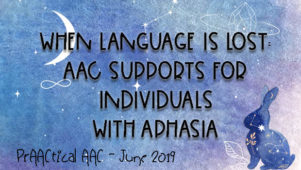
It’s another Throwback Thursday! In recognition of Aphasia Awareness Month, we are digging into the archives for content on supporting people who’ve lost a good deal of language following stroke, brain injury, or dementia. If this is a population of interest, we invite you to explore these past posts to get ideas of things to add to your AAC assessment and/or therapy. Making It Work: 6 AAC Strategies for People with Aphasia Low Tech AAC for Adults with Aphasia: What Does That Mean? A Fresh Look at AAC & Aphasia with Dr. Kristy Weissling 5 Questions about Aphasia & Communication Books Aphasia Awareness Month: AAC & Aphasia Bridging the Gap: Helping People with Aphasia to Compensate for Their Language Difficulties AAC Assessment for People with Aphasia
September 5, 2014
by Carole Zangari -
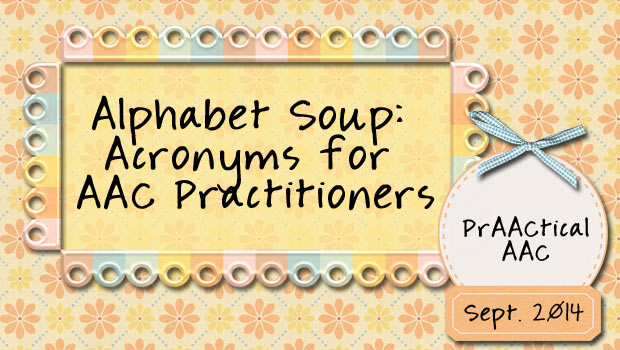
We’re excited about the passion and enthusiasm for AAC shown by many new SLPs and graduate student clinicians. One of the things they sometimes struggle with in reading and writing reports is the number of acronyms that we tend to use. This is always a problem in clinical and scholarly writing, but when the field is incredibly diverse and transdisciplinary, the challenges multiply. Here’s a starter list of acronyms* and their meanings. Many, MANY thanks to those who helped us create this list on the PrAACtical AAC Facebook page. AAC-RERC – AAC Rehabilitation Engineering Research Center ACOLUG – Augmentative Communication Online Users’ Group AiLS, ALgS, and ALs – Aided language stimulation ALI – Aided language input ALS – Amyotrophic lateral sclerosis AOTA – American Occupational Therapy Association APTA – American Physical Therapy Association ASD – Autism spectrum disorder ASHA – American Speech Language Hearing Association AT – Assistive technology ATIA... [Read More...]
June 12, 2014
by Carole Zangari -
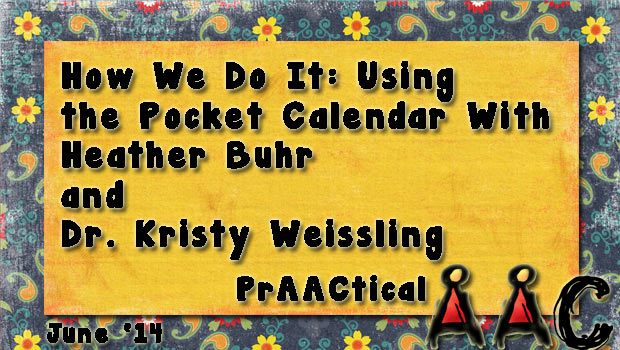
We are happy to welcome back our friend and colleague, Dr. Kristy Weissling, and her student Heather Buhr, who are sharing more information about an AAC tool they are using to support people with aphasia. Take a look at their Pocket Calendars, which may be beneficial to clients with other kinds of communication difficulties as well. You can see their original post, Low-Tech AAC for Adults with Aphasia, here. ::::::::::::::::::::::::::::::::::::::::::::::::::::::::::::::::::::::::::::::::::: In our last post we examined the differences between memory books and communication books. As promised, we are back again to share with you a low-tech “device” that we have been recently using- the pocket calendar. It’s simple, easy to use, comes together in a snap, and is probably familiar to your clients. We will review how our clients are using these pocket calendars, why we find them effective, and how to put one... [Read More...]
May 27, 2014
by Carole Zangari -
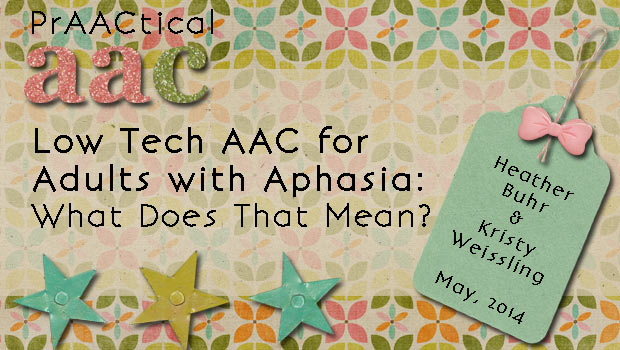
Aphasia Awareness Month is just around the corner, and getting us ready for that is this wonderful post on using low tech AAC with people who have aphasia. We’re delighted to welcome back our friend and colleague, Dr. Kristy Weissling, who is collaborating with Heather Buhr, to share some thoughts on this topic. ::::::::::::::::::::::::::::::::::::::::::::::::::::::::::::: For many, the term Augmentative and Alternative (AAC) brings to mind technology, speech-generating devices, and now – more than ever before – iPads. But as we know, AAC encompasses much more than that. We all use AAC when we make facial expressions or gestures, use symbols or pictures, or write. We would like to explore AAC and more “low-tech” options that help our clients express their thoughts, needs, wants, and ideas. Low-tech strategies can range from the use of written choice, to communication boards, to communication books. In this article we will specifically address communication... [Read More...]
April 16, 2014
by Carole Zangari -
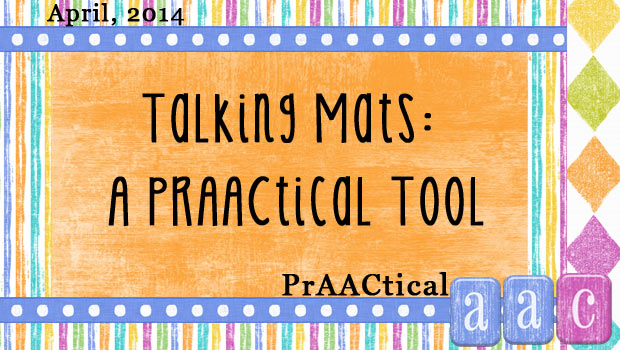
We’ve shared about Talking Mats in a video and on our Facebook page, but we needed to call on the experts to go into more detail about this approach. Thankfully, the co-directors of this project, Dr. Joan Murphy and Lois Cameron, were willing to collaborate. in this post, Dr. Murphy shares her knowledge with us. Hope you enjoy learning about the implementation of Talking Mats as much as we did. What is Talking Mats? Talking Mats is an innovative, award-winning communication tool which is based on extensive research and designed by Speech and Language Therapists in Scotland. Our vision is to improve the lives of people with communication difficulties by increasing their capacity to express their views about things that matter to them. Talking Mats is an interactive resource that uses three sets of picture symbols – top scale, topics and options and a space on which to display them.... [Read More...]
September 13, 2013
by Carole Zangari -
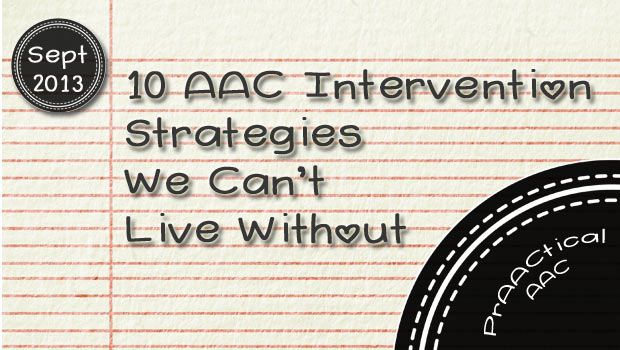
It’s a new semester for us and we’re having lots of conversations with student clinicians about teaching strategies. Here are some of the things they’re putting in their AAC toolkits. Making language visible: Use visual supports to give information, explain, set boundaries, and make expectations clear. Aided language input and focused language stimulation: Teach AAC by speaking AAC. Communication temptations: Make the client want to communicate to get his/her own agenda met Expansions and extensions: The language facilitation strategies we all studied in our language intervention classes work in AAC, too! Repetition with variety: Working on the same thing in different ways is a sure way to build learning and keep treidthings fresh Contrastive examples: Teach through the power of clear examples, both positive AND negative Backward and forward chaining: Great for teaching things that have multiple steps, like sending emails or posting to Facebook Structure: Creating structure helps learner better... [Read More...]
June 29, 2013
by Carole Zangari -
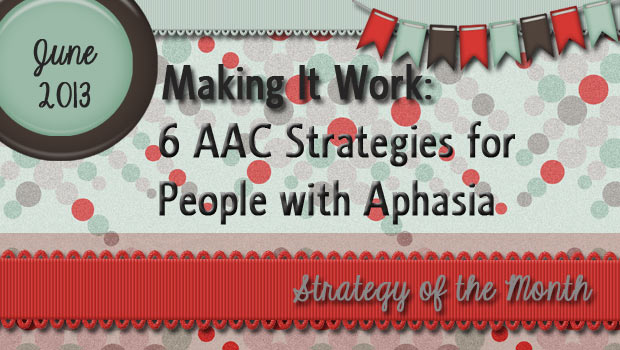
People with aphasia are often most successful when a number of different strategies are combined. In this post, we discuss a number of strategies that we can use in our therapy and teach to communication partners. Augmented Input We’ve written so many posts about aided language input that we’re almost embarrassed to bring it up again. Almost. It seems like no matter which age group or clinical population is the subject of our post, that strategy plays a central role. It is the same for people with aphasia with one exception. They benefit from a broader array of input cues, such as gestures, writing, and even pantomime. Augmented input is the term that is used to refer to oral language that is supplemented with pictures, print, gestures, pantomime, and the use of objects in the environment. By using these things as you speak, you enhance the ability of the person... [Read More...]
June 26, 2013
by Carole Zangari -
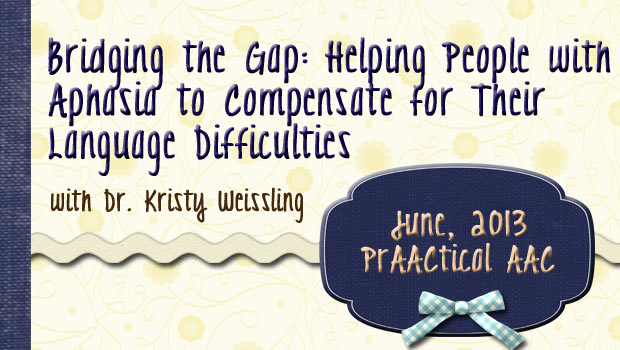
We’re wrapping up Aphasia Month with another fine post from Dr. Kristy Weissling. You can see her earlier posts here and here. In this post, Kristy shares her thoughts on how SLPs can use AAC supports to help individuals with aphasia compensate for their language difficulties. In 2010, my colleague, Carrie Prentice, and I talked about the role of both remediation and compensation in the speech rehabilitation programs of people with aphasia. At that time, we were trying to emphasize that at any particular time in the rehabilitation process, from acute care to outpatient rehabilitation, all possible alternatives should be balanced to create an individualized treatment program. Both restorative and compensatory mechanisms are available to therapist throughout this process. We proposed the work of Dixon, Garrett, and Backman (2008) to formulate a framework for discussing compensation. Six mechanisms of compensation were identified in their chapter on principles of compensation in... [Read More...]
June 22, 2013
by Robin Parker -
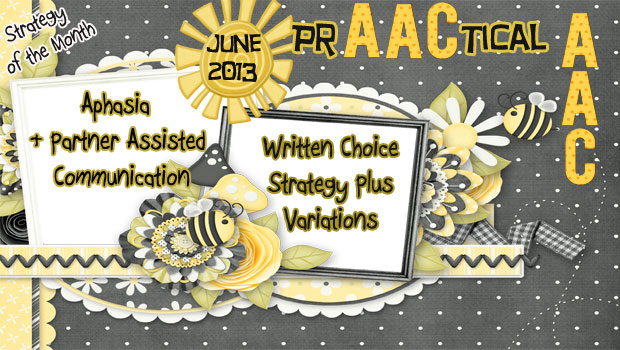
This month, we have enjoyed writing about communication strategies for aphasia. Partner supported communication is the platform for many of the effective techniques we use to help people with aphasia initiate, maintain, or terminate communication and conversation. We have talked about assessment strategies, communication books, and alphabet & topic supplementation. Now it is time to discuss the written choice strategy. The written choice strategy is fairly easy to implement, can look natural, and can result in seamless detailed conversation. Written choices are provided in the context of conversation and are displayed in an organized manner. What is It? The written choice strategy has the partner/facilitator generating written key-word choices that relate to the conversational topic. The written choices can be paired with text, pictures, drawings, symbols, and natural speech. The partner/facilitator writes possible answers to conversational questions in list form. The conversation is extended as continued written choices are offered... [Read More...]









